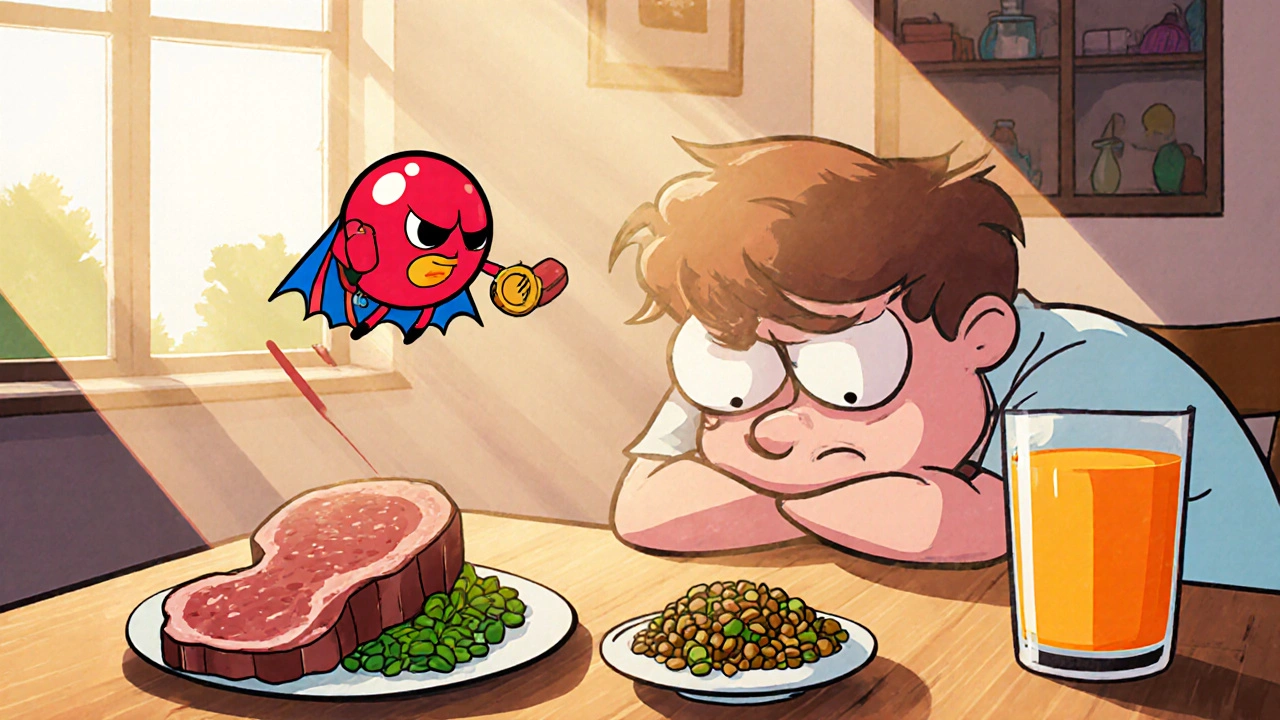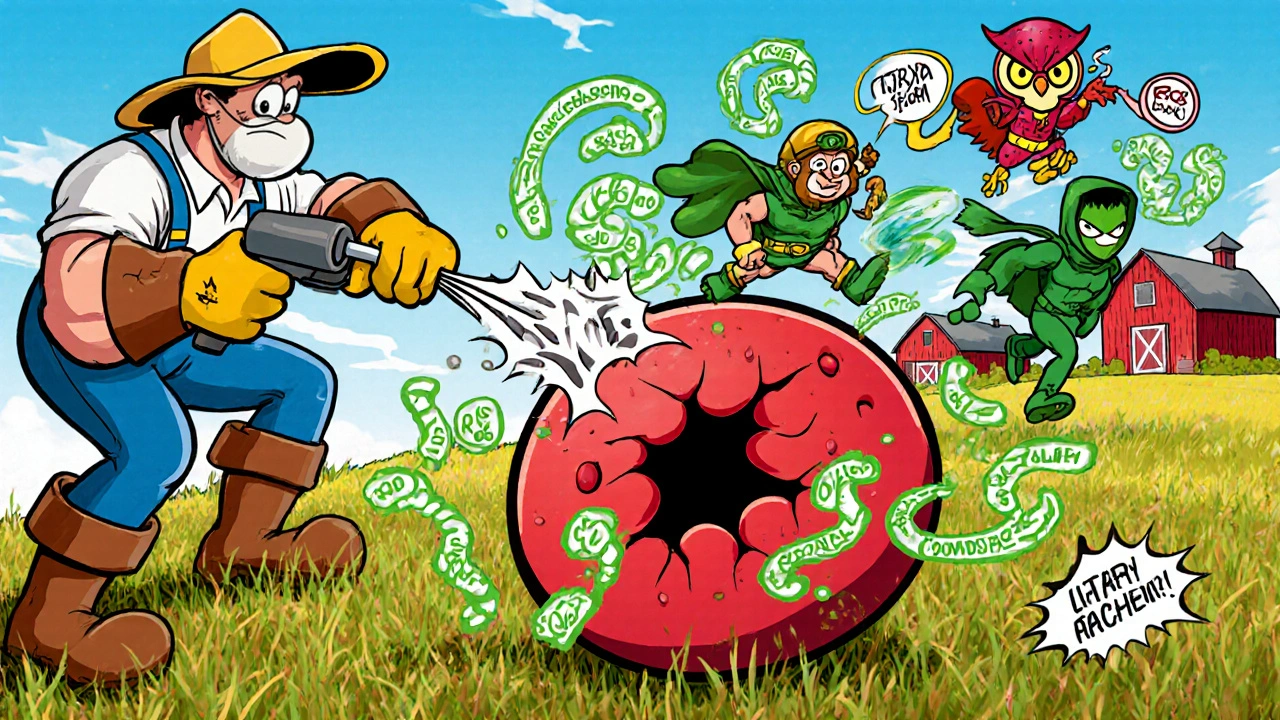
Pesticide Exposure & Nutrient Deficiency Risk Calculator
Calculate Your Combined Risk
This tool estimates how nutrient deficiencies and pesticide exposure interact to increase anemia risk based on scientific evidence from agricultural studies.
Anemia is a condition where hemoglobin levels or red blood cell counts drop below normal, causing fatigue, shortness of breath, and reduced oxygen delivery to tissues. When pesticide exposure means contact with agricultural chemicals that can disrupt enzymes, hormone pathways, and cellular metabolism, the body’s ability to compensate for low iron or other nutrient gaps gets worse. In short, the combo of a nutritional deficiency and pesticide toxicity creates a perfect storm for anemia.
Key Takeaways
- Iron, B‑12, and folate deficiencies make the body more vulnerable to pesticide‑induced oxidative stress.
- Organophosphates and glyphosate are the pesticide groups most frequently linked to reduced hemoglobin and red blood cell production.
- Detoxification enzymes like GST and CYP450 are nutrient‑dependent; lacking cofactors impairs pesticide clearance.
- Symptoms often overlap-fatigue, headache, and pallor-so clinicians should screen for both nutritional gaps and chemical exposure.
- Dietary adjustments, protective equipment, and reduced pesticide use can break the cycle and restore healthy blood counts.
Why Nutritional Deficiencies Matter
Iron, vitamin B12, and folate are the three big players in red blood cell (RBC) production. Iron is the core of the heme molecule that carries oxygen. B12 and folate work together in DNA synthesis, which is essential for generating new RBCs in the bone marrow. When any of these nutrients dip below the required threshold, the marrow slows down, and the body’s oxygen‑carrying capacity drops.
But the story doesn’t stop at a simple lack of building blocks. Deficiencies also weaken the body’s antioxidant defenses. Iron‑dependent enzymes like catalase and B12‑dependent methionine synthase help neutralize free radicals. Without them, oxidative stress climbs, and cell membranes-including those of RBCs-get damaged more easily.
How Pesticides Attack the Blood
Pesticides come in many flavors, but two classes dominate the conversation about anemia: organophosphates (e.g., chlorpyrifos, malathion) and glyphosate‑based herbicides. Both interfere with biochemical pathways that the blood relies on.
- Organophosphates inhibit acetylcholinesterase, leading to excess acetylcholine. This overstimulation can cause chronic inflammation, which suppresses erythropoietin (the hormone that tells the marrow to make RBCs).
- Glyphosate chelates minerals like manganese and zinc, reducing the activity of superoxide dismutase (SOD) and glutathione peroxidase-key antioxidants that protect RBC membranes.
Both groups also trigger the production of reactive oxygen species (ROS). When ROS pile up, they damage hemoglobin and the membrane surrounding each cell, shortening the lifespan of RBCs from the usual 120 days to as little as 60‑70 days.
Biochemical Bridge: Detox Enzymes Depend on Nutrients
The liver’s detoxification system-primarily the glutathione‑S‑transferase (GST) family and cytochrome P450 (CYP450) enzymes-relies on micronutrients as cofactors. Glutathione itself is a tripeptide made from cysteine, glutamate, and glycine; its synthesis needs adequate B‑vitamins. CYP450 enzymes need iron‑sulfur clusters and heme groups, meaning iron deficiency directly hampers pesticide metabolism.
When you lack these nutrients, the body can’t break down pesticides efficiently. The chemicals linger longer, generating more ROS and further depleting antioxidants-a vicious feedback loop that accelerates anemia.

Real‑World Evidence
Several epidemiological studies from agricultural regions illustrate the link. A 2023 cohort in the Midwestern United States found that farmworkers with hemoglobin <12g/dL were 1.8 times more likely to report daily exposure to organophosphates than workers with normal levels. The same study noted that participants with serum ferritin below 15µg/L showed the strongest association.
Another 2024 case‑control study in Brazil compared women with iron‑deficiency anemia to matched controls. Those with anemia had a 2.3‑fold higher urinary glyphosate concentration, even after adjusting for diet and socioeconomic status.
These data reinforce a mechanistic picture: nutrient shortages amplify pesticide toxicity, and the combined assault pushes blood parameters into the anemia range.
Identifying the Dual Threat in Clinical Practice
Because fatigue, headache, and pallor are shared symptoms, doctors need a focused history and targeted labs.
- Exposure assessment: Ask about occupation, residence near farms, use of home pesticides, and diet rich in conventionally grown produce.
- Blood work: CBC with RBC indices, serum ferritin, transferrin saturation, vitamin B12, folate, and homocysteine levels.
- Biomonitoring: If exposure is suspected, order urinary organophosphate metabolites (e.g., dialkyl phosphates) or glyphosate urine tests.
- Oxidative stress markers: Measure malondialdehyde (MDA) or glutathione levels when available.
When labs reveal both a deficiency and elevated pesticide metabolites, treatment should address both arms of the problem.
Practical Steps to Break the Cycle
The good news is that lifestyle changes can restore balance.
- Boost iron intake: Lean red meat, lentils, and iron‑fortified cereals. Pair with vitamin C‑rich foods (citrus, bell peppers) to improve absorption.
- Support B12 and folate: Include eggs, dairy, fortified plant milks, leafy greens, and, if needed, a B‑complex supplement.
- Protect against pesticides: Use gloves and masks when handling chemicals, wash produce thoroughly, and consider organic options for high‑pesticide crops like strawberries and spinach.
- Enhance detox pathways: Sulfur‑rich foods (onions, garlic, cruciferous veggies) and selenium‑rich Brazil nuts help replenish glutathione and support CYP450 function.
- Medical intervention: In severe cases, iron infusions, B12 injections, or folate supplementation may be required alongside detox‑supportive therapies like N‑acetylcysteine (NAC).
Following these steps can raise hemoglobin, improve antioxidant capacity, and speed up pesticide clearance, ultimately reducing the anemia burden.

Comparison of Common Pesticide Classes and Their Anemia‑Related Risk
| Class | Key Chemicals | Mechanism Linking to Anemia | Typical Exposure Scenarios |
|---|---|---|---|
| Organophosphates | Chlorpyrifos, Malathion | Acetylcholinesterase inhibition → chronic inflammation → ↓ erythropoietin; ROS generation damages RBCs | Crop spraying, residential pest control |
| Glyphosate‑based herbicides | Glyphosate (Roundup®), AMPA | Mineral chelation (Zn, Mn) → ↓ antioxidant enzymes; direct oxidative damage to hemoglobin | Weed control in gardens, large‑scale agriculture |
| Carbamates | Carbaryl, Propoxur | Similar to organophosphates but milder; may interfere with mitochondrial function in RBC precursors | Fruit orchards, indoor pest control |
| Pyrethroids | Permethrin, Cypermethrin | Induces oxidative stress; occasional hemolysis reported in sensitive individuals | Home insect sprays, livestock tick control |
Frequently Asked Questions
Can a normal diet protect me from pesticide‑related anemia?
A diet rich in iron, B12, and folate certainly helps, but it’s not a complete shield. Reducing direct pesticide contact-through protective gear, washing produce, or choosing organic options-adds an essential layer of protection.
Do all pesticides cause anemia?
No. The strongest links appear with organophosphates and glyphosate because they generate oxidative stress and interfere with nutrient‑dependent detox enzymes. Other classes may cause anemia only in high‑dose or highly sensitive cases.
How long does it take for blood counts to improve after reducing exposure?
If you supplement the missing nutrients and cut exposure, hemoglobin can rise within 4‑6 weeks. Full normalization may take 2‑3 months, depending on the severity of the deficiency and how quickly the body clears the pesticide residues.
Are urine tests reliable for detecting pesticide exposure?
For organophosphates, measuring dialkyl phosphate metabolites is standard and fairly sensitive. Glyphosate detection in urine is also reliable, but timing matters-samples should be taken within 24‑48hours of the suspected exposure.
Should I take antioxidant supplements if I’m worried about pesticides?
Supplementing with Vitamin C, Vitamin E, and NAC can boost glutathione levels, but they work best when paired with a nutrient‑replete diet. Over‑dosing on antioxidants alone won’t fix a mineral deficiency that hampers detox enzymes.
Bottom Line
The connection between anemia and pesticide exposure isn’t a coincidence; it’s a biochemical cascade where nutrient gaps lower the body’s defense against toxic chemicals, and those chemicals, in turn, accelerate red‑cell loss. By spotting both the dietary shortfall and the exposure route, you can intervene on two fronts-feeding the blood with the right iron, B12, and folate, while cutting down on harmful pesticide contact. The result? Healthier blood, sharper energy, and a lower risk of long‑term chronic disease.
Comments (6)
-
Dion Campbell October 16, 2025
One cannot simply dismiss the intricate nexus between hematologic integrity and xenobiotic exposure as a trivial footnote to occupational health. The discourse surrounding anemia, particularly when intertwined with agrochemical insults, demands a lexicon befitting its gravitas. It is an elegant tragedy when micronutrient paucity renders the erythropoietic cascade vulnerable to the insidious machinations of organophosphates and glyphosate. Such a confluence, dear interlocutors, is not merely a biochemical curiosity but a clarion call for rigorous scientific scrutiny.
-
Burl Henderson October 28, 2025
Absolutely, the interplay of iron, B‑12, and folate with detox pathways is a classic case of systems biology. When the liver's GST and CYP450 falter, the oxidative burden spikes, aggravating hemolysis. In practice, we see workers with sub‑optimal micronutrient status exhibit prolonged pesticide half‑lives, which aligns with the pharmacokinetic models. Addressing these gaps could calibrate the metabolic clearance rates and mitigate the anemia cascade.
-
Leigh Ann Jones November 8, 2025
Indeed, the cascade of events that precipitates this form of anemia is profoundly multifactorial and warrants an exhaustive exposition. To begin with, iron, as the central atom in the heme moiety, is indispensable for oxygen transport, yet its deficiency precipitates a cascade of compensatory mechanisms that ultimately undermine red blood cell maturation. Simultaneously, vitamin B12 and folate orchestrate the methylation cycles and nucleotide synthesis, thereby ensuring the fidelity of DNA replication within the hematopoietic marrow. When these micronutrients dwindle, the marrow's proliferative vigor is attenuated, resulting in a measurable decrement in hemoglobin concentration. Concurrently, pesticides such as organophosphates exert a neurotoxic influence that amplifies systemic inflammation, which in turn suppresses erythropoietin synthesis, the hormonal lynchpin driving erythropoiesis. Moreover, glyphosate's chelating properties deplete essential trace elements like manganese and zinc, eroding the activity of superoxide dismutase and glutathione peroxidase, pivotal enzymes that safeguard erythrocyte membranes from oxidative onslaught. The resultant surge in reactive oxygen species precipitates lipid peroxidation, destabilizing the phospholipid bilayer of red cells and truncating their lifespan from the normative 120 days to a precarious 60‑70 days. On a hepatic level, the glutathione‑S‑transferase family and cytochrome P450 enzymes, both of which are contingent upon adequate supplies of cysteine, iron, and various B‑vitamins, become incapacitated in the face of nutrient insufficiency, leading to a protracted half‑life of the offending xenobiotics. This protraction fuels a vicious cycle wherein lingering pesticide residues perpetuate oxidative stress, further depleting antioxidant reserves, and thereby accentuating the anemic phenotype. Epidemiological surveys from agrarian regions consistently underscore this bidirectional relationship, demonstrating that farms employing rigorous personal protective equipment and nutritional supplementation report markedly lower incidence rates of pesticide‑associated anemia. In summation, the synergistic derailment of micronutrient homeostasis and xenobiotic metabolism constructs a perfect storm that inexorably drives hematologic decline, necessitating a holistic approach encompassing dietary optimization, exposure mitigation, and vigilant clinical monitoring.
-
Robert Brown November 20, 2025
Stop ignoring the data.
-
Erin Smith December 1, 2025
Great info keep it up you can do it
-
George Kent December 13, 2025
Really!!!??? This is absolutely !!! unbelievable ;;; The facts are clear!!! 👍👍👍
